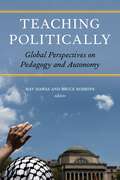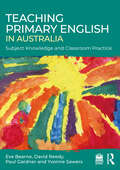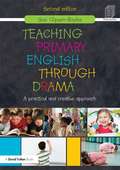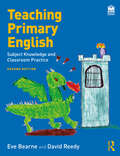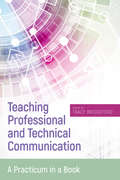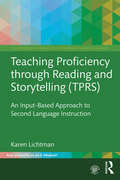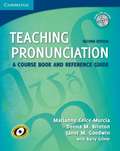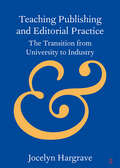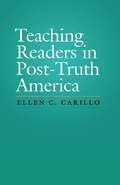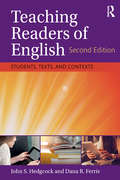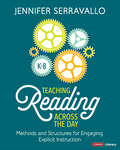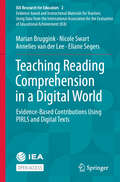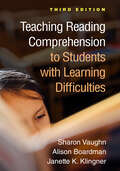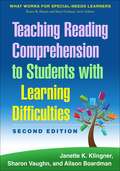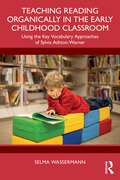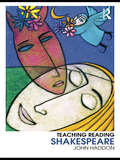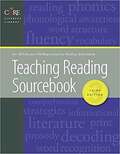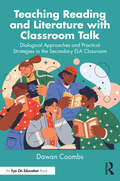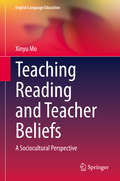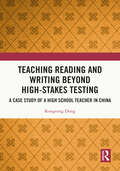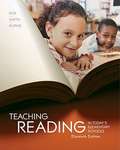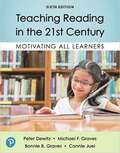- Table View
- List View
Teaching Politically: Global Perspectives on Pedagogy and Autonomy
by May Hawas and Bruce RobbinsCulture is inextricable from politics. This includes the politics of who we are, as teachers, intellectuals, writers, cultural workers, and students, and what we want to bring to and take from the site of instruction. It also includes the politics of who we want to be, as citizens, professionals, and active contributors to our communities and to the world in general, and what we can be, realistically, in the particular contexts in which we live. Teaching Politically addresses some of the political constraints that shape our pedagogical spaces, especially in the teaching of literature. The book brings together a global group of academics, activists, public intellectuals, poets, and novelists to examine the way politics manifest pedagogically, and how a commitment to educating manifests politically, in and beyond the classroom. At the heart of the discussion is how political and professional paradigms chafe against, intersect with, or otherwise become inseparable from each other in any vocation that attempts to educate: from writing, journalism, and public speaking to art, activism, and medicine.Contributors: Dimitris Christopoulos, Dimitri Dimoulis, Khaled Fahmy, Rishi Goyal, May Hawas, Bonnie Honig, Mona Kareem, Benjamin Mangrum, Nora Parr, Bruce Robbins, Ahdaf Soueif, Omid Tofighian, Elahe Zivardar
Teaching Postcolonial Environmental Literature and Media (Options for Teaching #56)
by Cajetan IhekaTaking up the idea that teaching is a political act, this collection of essays reflects on recent trends in ecocriticism and the implications for pedagogy. Focusing on a diverse set of literature and media, the book also provides background on historical and theoretical issues that animate the field of postcolonial ecocriticism. The scope is broad, encompassing not only the Global South but also parts of the Global North that have been subject to environmental degradation as a result of colonial practices. Considering both the climate crisis and the crisis in the humanities, the volume navigates theoretical resources, contextual scaffolding, classroom activities, assessment, and pedagogical possibilities and challenges. Essays are grounded in environmental justice and the project to decolonize the classroom, addressing works from Africa, New Zealand, Asia, and Latin America and issues such as queer ecofeminism, disability, Latinx literary production, animal studies, interdisciplinarity, and working with environmental justice organizations.
Teaching Postwar Japanese Fiction (Options for Teaching #60)
by Alex BatesAs Japan moved from the devastation of 1945 to the economic security that survived even the boom and bust of the 1980s and 1990s, its literature came to embrace new subjects and styles and to reflect on the nation's changing relationship to other Asian countries and to the West. This volume will help instructors introduce students to novels, short stories, and manga that confront postwar Japanese experiences, including the suffering caused by the atomic bombings of Hiroshima and Nagasaki, the echoes of Japan's colonialism and imperialism, new ways of thinking about Japanese identity and about minorities such as the zainichi Koreans, changes in family structures, and environmental disasters. Essays provide context for understanding the particularity of postwar Japanese literature, its place in world literature, and its connections to the Japanese past.
Teaching Primary English in Australia: Subject Knowledge and Classroom Practice
by Eve Bearne David Reedy Paul Gardner Yvonne SawersThis first Australian edition of Teaching Primary English has been updated and adapted to reflect the Australian sociocultural and educational context. This text provides a comprehensive, evidence informed introduction to teaching and learning English in the primary school classroom. New content refers to the Australian English Curriculum and incorporates Aboriginal and Torres Strait Islander perspectives and literacy perspectives relevant to the Asia-Pacific region as well as the broader international context. This edition also includes a new section devoted to visual literacy, critical literacy and multimodality. Teaching advice and ideas are supported by practical examples linked to video clips filmed in real schools, reflective activities, observational tasks and online resources. Each section includes suggestions for great children’s literature and offers assessment advice and support for planning for diversity and special educational needs. Drawing on the very latest research and theory, supported by practical examples and guidance, this is an essential resource for pre-service teachers as they develop subject knowledge and the skills and confidence to deliver effective and engaging classroom practice.
Teaching Primary English through Drama: A practical and creative Approach
by Suzi Clipson-Boyles"The text is extraordinarily succinct, very well organised and highly readable. Each chapter examines in depth specific aspects of teaching and learning in drama and well-chosen practical examples can readily be adopted by teachers. A 'must' for all primary schools." Drama (the Journal of National Drama) Review of ‘Drama in Primary English teaching’ Teaching Primary English through Drama builds on the success of the classic text Drama in Primary English, inspiring ideas and techniques for teaching English skills through the medium of drama. Focusing on the power of drama to promote effective learning in primary education, Suzi Clipson-Boyles demonstrates how reading, writing, speaking and listening skills may be developed in ways that will motivate and engage pupils. She uses specific examples from the English curriculum, and also makes links to other areas of the curriculum. In addition, the book explains how assessment during drama can help teachers to evaluate pupils’ progress in English. Further guidance is given on how drama can enrich studying for pupils who are learning English as a foreign language. The book also provides a chapter on developing drama as an art form in its own right, with simple ideas and practical suggestions on how to enhance performances. Teaching Primary English through Drama presents a wide range of drama approaches from ten-minute starter activities to stimulate ideas such as fun ways to practise reading, through to longer projects that can provide contexts for extended writing or help with presentation and performance. The chapters show how drama can help to bring lessons alive in imaginative ways that not only promote enjoyment but also enhance achievement. This comprehensive and practical guide offers essential reading for primary teachers and other practitioners, and is a valuable resource to trainees. It also provides an excellent foundation for those who wish to extend their expertise further towards drama as a subject specialism.
Teaching Primary English: Subject Knowledge and Classroom Practice
by Eve Bearne David ReedyNow in its second edition, Teaching Primary English is a bestselling, comprehensive, evidence-informed guide designed to support and inspire teaching and learning in the primary school. Written in a clear and accessible way, it draws on the very latest research and theory to describe and exemplify a full and rich English curriculum. It offers those on teacher training courses, as well as qualified teachers who are looking to develop their practice, invaluable subject knowledge and guidance for effective, enjoyable classroom practice. Throughout there is an emphasis on equity and inclusion. Advice and ideas are supported by explicit examples of good teaching linked to video clips filmed in real schools, reflective activities, observational tasks and online resources. Each chapter includes suggestions for great children’s literature, considers assessment throughout and offers support in planning for inclusion and special educational needs. New and expanded areas for this edition include: Multimodal texts Increased coverage of Early Years Dialogic learning and oracy Comprehensive companion website with revised and additional resources A new section on digital literacies Reading for pleasure Teaching grammar in context Critical literacy With a focus on connecting all modes of English, the global and the local, and home and school experience, this detailed, uplifting book, includes inspiring case studies throughout and will support you in developing a curious, critical approach to teaching and learning English. Additional content can be found on the fantastic supporting website. Features include: Video clips from within the classroom to demonstrate English teaching techniques Audio resources, including an interactive quiz, to check understanding and provide real-life examples and case studies Downloadable resources to support teaching and incorporate into lesson plans.
Teaching Professional and Technical Communication: A Practicum in a Book
by Dan Jones Traci Nathans-Kelly Christine G. Nicometo Pam Estes Brewer Kirk St. Amant Karla Saari Kitalong Dave Clark Eva Brumberger Paul Dombrowski James M. Dubinsky Peter S. England David K. Farkas Brent Henze Tharon W. HowardTeaching Professional and Technical Communication guides new instructors in teaching professional and technical communication (PTC). The essays in this volume provide theoretical and applied discussions about the teaching of this diverse subject, including relevant pedagogical approaches, how to apply practical aspects of PTC theory, and how to design assignments. This practicum features chapters by prominent PTC scholars and teachers on rhetoric, style, ethics, design, usability, genre, and other central concerns of PTC programs. Each chapter includes a scenario or personal narrative of teaching a particular topic, provides a theoretical basis for interpreting the narrative, illustrates the practical aspects of the approach, describes relevant assignments, and presents a list of questions to prompt pedagogical discussions. Teaching Professional and Technical Communication is not a compendium of best practices but instead offers a practical collection of rich, detailed narratives that show inexperienced PTC instructors how to work most effectively in the classroom. Contributors: Pam Estes Brewer, Eva Brumberger, Dave Clark, Paul Dombrowski, James M. Dubinsky, Peter S. England, David K. Farkas, Brent Henze, Tharon W. Howard, Dan Jones, Karla Saari Kitalong, Traci Nathans-Kelly, Christine G. Nicometo, Kirk St.Amant
Teaching Proficiency Through Reading and Storytelling: An Input-Based Approach to Second Language Instruction (The Routledge E-Modules on Contemporary Language Teaching)
by Karen LichtmanThis module introduces Teaching Proficiency through Reading and Storytelling (TPRS), an input-based language teaching method. TPRS provides a framework for teaching classes completely in the target language—even those at the beginner level. Through the steps of establishing meaning, creating a story that is acted out live in class, and reading, students understand and use the target language to communicate right away. Research shows that over time TPRS creates fluent speakers who excel both on traditional tests and—more importantly—in real-life situations. This is a valuable resource on TPRS for world language teachers, language teacher educators, and second language researchers.
Teaching Pronunciation: A Course Book and Reference Guide
by Donna M. Brinton Marianne Celce-Murcia Janet M. Goodwin Barry D. GrinerThe second edition includes updates and insights on current research and pedagogical practice that have developed over the last decade. This new edition of Teaching Pronunciation - undoubtedly the gold standard for pronunciation methodology texts - has been revised to reflect recent research into the sound system of North American English, as well as new practices in pronunciation pedagogy.
Teaching Publishing and Editorial Practice: The Transition from University to Industry (Elements in Publishing and Book Culture)
by Jocelyn HargraveA key challenge facing all educators working in practice-based subjects is the need to negotiate tensions between past and present and provide a training that prepares students for fast-changing conditions, while also conveying long-standing principles. This Element therefore investigates how effectively editing and publishing programmes prepare graduates for industry and how well these graduates translate this instruction to the workplace. Taking a global perspective to gauge the state of the discipline, the mixed-methods approach used for this Element comprised two online surveys for educators and graduates, three semi-structured interviews with industry practitioners (scholarly, education and trade) and ethnographic practice (author as educator and practitioner). Three key concepts also framed this Element's enquiry: being, learning and doing. The Element demonstrates how these transitioning but interdependent concepts have the potential to form a holistic practice-led pedagogy for students of editing and publishing programmes.
Teaching Readers in Post-Truth America
by Ellen C. CarilloTeaching Readers in Post-Truth America shows how postsecondary teachers can engage with the phenomenon of “post-truth.” Drawing on research from the fields of educational and cognitive psychology, human development, philosophy, and education, Ellen C. Carillo demonstrates that teaching critical reading is a strategic and targeted response to the current climate. Readers in this post-truth culture are under unprecedented pressure to interpret an overwhelming quantity of texts in many forms, including speeches, news articles, position papers, and social media posts. In response, Carillo describes pedagogical interventions designed to help students become more metacognitive about their own reading and, in turn, better equipped to respond to texts in a post-truth culture. Teaching Readers in Post-Truth America is an invaluable source of support for writing instructors striving to prepare their students to resist post-truth rhetoric and participate in an information-rich, divisive democratic society.
Teaching Readers of English: Students, Texts, and Contexts
by Dana R. Ferris John S. HedgcockA comprehensive manual for pre- and in-service ESL, EFL, and EIL educators who work with multilingual students at the secondary and postsecondary levels, this text balances insights from reading theory and research with highly practical, field-tested strategies for teaching and assessing second-language reading that educators can readily adopt and adapt to suit their contexts and student populations. Teaching Readers of English is a complete "go-to" source for teaching reading and promoting classroom and professional literacies in an increasingly digital world. Offering principled approaches and methods for planning and delivering effective L2 reading instruction, the text includes pedagogical features, such as questions for reflection, further reading and resources, and application activities to develop purposeful classroom reading lessons in a range of contexts. Changes in the Second Edition: Updated and revised chapters on formative and summative reading assessment, developing vocabulary knowledge and grammatical skill, and cultivating extensive reading and literary appreciation Updated information on institutional settings and reader demographics New pedagogical features in each chapter, including Chapter Summaries, Further Reading, Reflection and Review, and Application Activities A streamlined chapter sequence to enhance the text’s usability
Teaching Reading Across the Day, Grades K-8: Methods and Structures for Engaging, Explicit Instruction
by Jennifer Serravallo"Reading well across disciplines and within varied contexts will help students to be versatile, flexible, deep readers who can better learn from their reading, transfer skills across subjects, and use strategies to meet the unique demands of reading in each content area." – Jennifer Serravallo Research-based, easy-to-use lesson structures for explicit and engaging teaching In Teaching Reading Across the Day, literacy expert Jennifer Serravallo provides nine effective, predictable, research-based lesson structures that help busy teachers save planning time and focus their teaching—and student attention—on content rather than procedures. Each of the nine lesson structures (read aloud, phonics and spelling, vocabulary, focus, shared reading, close reading, guided inquiry, reader’s theater, and conversation) has its own chapter and features a wealth of resources that let you see the lessons in action in ELA, Science, and Social Studies classes, including: An annotated teaching vignette, lesson explanation, and research notes Tips for planning, structure and timing suggestions, and ideas for responsive teaching Detailed planning templates and 22 accompanying online videos covering over 3 hours of classroom footage Jen’s reflections, key look-fors, and ideas for next steps The nine lesson structures can be used with any curriculum or core program, text, and subject, making it easier for teachers to maximize explicit and engaging teaching time across the day, and simplify planning and preparation. Jen incorporates a wide range of compelling research about how best to teach reading to every student in your class and translates the research (or the science of teaching reading) into high-leverage moves you can count on to deliver powerful lessons again and again. She also honors the art of teaching reading, helping teachers tap into their experience and hone their expertise to make quick, effective classroom decisions that take student learning to the next level.
Teaching Reading Across the Day, Grades K-8: Methods and Structures for Engaging, Explicit Instruction
by Jennifer Serravallo"Reading well across disciplines and within varied contexts will help students to be versatile, flexible, deep readers who can better learn from their reading, transfer skills across subjects, and use strategies to meet the unique demands of reading in each content area." – Jennifer Serravallo Research-based, easy-to-use lesson structures for explicit and engaging teaching In Teaching Reading Across the Day, literacy expert Jennifer Serravallo provides nine effective, predictable, research-based lesson structures that help busy teachers save planning time and focus their teaching—and student attention—on content rather than procedures. Each of the nine lesson structures (read aloud, phonics and spelling, vocabulary, focus, shared reading, close reading, guided inquiry, reader’s theater, and conversation) has its own chapter and features a wealth of resources that let you see the lessons in action in ELA, Science, and Social Studies classes, including: An annotated teaching vignette, lesson explanation, and research notes Tips for planning, structure and timing suggestions, and ideas for responsive teaching Detailed planning templates and 22 accompanying online videos covering over 3 hours of classroom footage Jen’s reflections, key look-fors, and ideas for next steps The nine lesson structures can be used with any curriculum or core program, text, and subject, making it easier for teachers to maximize explicit and engaging teaching time across the day, and simplify planning and preparation. Jen incorporates a wide range of compelling research about how best to teach reading to every student in your class and translates the research (or the science of teaching reading) into high-leverage moves you can count on to deliver powerful lessons again and again. She also honors the art of teaching reading, helping teachers tap into their experience and hone their expertise to make quick, effective classroom decisions that take student learning to the next level.
Teaching Reading Comprehension in a Digital World: Evidence-Based Contributions Using PIRLS and Digital Texts (IEA Research for Educators #2)
by Marian Bruggink Nicole Swart Annelies van der Lee Eliane SegersThis open access book helps teachers include the reading of digital texts in their curriculum. Using ePIRLS, it informs teachers about digital reading and evidence-based teaching principles for digital reading. This publication raises awareness about digital inclusion within schools and how this affects students’ opportunities to learn. This volume describes recent scientific insights regarding digital reading and emphasizes the importance of digital inclusion within schools. Evidence-based didactic guidelines for digital reading are described to help teachers learn more about supporting their students in reading digital texts. Using an ePIRLS text, it discusses the challenges students encounter in reading digital texts and concretizes the didactic suggestions. Additionally, good practices from PIRLS countries regarding digital reading are highlighted, which can be an inspiration to teachers across the world.
Teaching Reading Comprehension to Students with Learning Difficulties (The Guilford Series on Intensive Instruction)
by Sharon Vaughn Janette K. Klingner Alison BoardmanNow in a revised and expanded third edition, this important resource helps teachers understand how good readers comprehend text and how best to support students who are struggling. It presents effective instructional methods for learners at all grade levels, including those with reading disabilities. Every chapter translates state-of-the-art research into practical classroom applications. All facets of comprehension are addressed, including assessment, vocabulary, background knowledge, and text structure. Chapters also cover English learners, intensive intervention, and content literacy. Utility as a teacher guide and course text is enhanced by sample lesson plans, graphic organizers, and chapter-opening study questions. New to This Edition *Chapter on text selection and text structure. *Chapter on teachers' frequently asked questions, providing specific, actionable advice. *More than twice as many sample lesson plans. *Revised throughout with the latest research and teaching techniques.
Teaching Reading Comprehension to Students with Learning Difficulties, 2/E
by Sharon Vaughn Janette K. Klingner Alison BoardmanThis practitioner resource and course text has given thousands of K-12 teachers evidence-based tools for helping students--particularly those at risk for reading difficulties--understand and acquire new knowledge from text. The authors present a range of scientifically validated instructional techniques and activities, complete with helpful classroom examples and sample lessons. The book describes ways to assess comprehension, build the skills that good readers rely on, and teach students to use multiple comprehension strategies flexibly and effectively. Each chapter features thought-provoking discussion questions. Reproducible lesson plans and graphic organizers can be downloaded and printed in a convenient 8 1/2" x 11" size. New to This Edition *Chapters on content-area literacy, English language learners, and intensive interventions. *Incorporates current research on each component of reading comprehension. *Discusses ways to align instruction with the Common Core State Standards. *Additional instructional activities throughout.
Teaching Reading Organically in the Early Childhood Classroom: Using the Key Vocabulary Approaches of Sylvia Ashton-Warner
by Selma WassermannThis book offers pre-service and practicing teachers the tools, materials, teaching strategies, and theoretical understandings to implement an organic reading program for beginning readers.Utilizing the work of Sylvia Ashton-Warner and field research carried out in nine multi-age early childhood classrooms, the book advocates for organic teaching methods to promote children’s love of reading and life-long literacy. Written in a narrative style, each chapter describes teaching strategies that are easily accessible and includes real-life classroom examples to make the implementation of an organic primary literacy program clear. With this approach, the book seeks to instill the desire and appreciation for reading; validates how books nurture and inform our lives; provides the tools and the skills to decode unknown words (word analysis skills); confirms how language is integral not only to reading but also to other language arts, such as spelling, word definitions, comprehension, reading aloud, and speaking; and provides the means for readers to make intelligent interpretations of text, from what is on the surface to those underlying meanings.This is a key resource for pre-service teachers and teacher educators in early literacy and early childhood curriculum courses, as well as reading specialists and students seeking teaching certification.
Teaching Reading Shakespeare
by John HaddonTeaching Reading Shakespeare is warmly and clearly communicated, and gives ownership of ideas and activities to teachers by open and explicit discussion. John Haddon creates a strong sense of community with teachers, raising many significant and difficult issues, and performing a vital and timely service in doing so. - Simon Thomson, Globe Education, Shakespeare’s Globe John Haddon offers creative, systematic and challenging approaches which don’t bypass the text but engage children with it. He analyses difficulty rather than ignoring it, marrying his own academic understanding with real sensitivity to the pupils’ reactions, and providing practical solutions. - Trevor Wright, Senior Lecturer in Secondary English, University of Worcester, and author of 'How to be a Brilliant English Teacher', also by Routledge. Teaching Reading Shakespeare is for all training and practising secondary teachers who want to help their classes overcome the very real difficulties they experience when they have to ‘do’ Shakespeare. Providing a practical and critical discussion of the ways in which Shakespeare’s plays present problems to the young reader, the book considers how these difficulties might be overcome. It provides guidance on: confronting language difficulties, including ‘old words’, meaning, grammar, rhetoric and allusion; reading the plays as scripts for performance at Key Stage 3 and beyond; using conversation analysis in helping to read and teach Shakespeare; reading the plays in contextual, interpretive and linguistic frameworks required by examinations at GCSE and A Level. At once practical and principled, analytical and anecdotal, drawing on a wide range of critical reading and many examples of classroom encounters between Shakespeare and young readers, Teaching Reading Shakespeare encourages teachers to develop a more informed, reflective and exploratory approach to Shakespeare in schools.
Teaching Reading Sourcebook
by Paige C. Pullen Roxanne F. Hudson Bill Honig Jacalyn Mahler Linda Diamond Linda Gutlohn Carrie L. Cole Pamela Beard El-Dinary Holly B. LaneThe CORE Literacy Training Series gives teachers in grades K-8 the tools they need to become skillful reading teachers. The three titles in the series provide (1) thorough background and effective teaching methods, (2) a comprehensive classroom assessment system, and (3) a compilation of the research on which effective reading instruction is based.
Teaching Reading and Literature with Classroom Talk: Dialogical Approaches and Practical Strategies in the Secondary ELA Classroom
by Dawan CoombsThis book presents a framework for conceptualizing and enacting dialogic approaches to teaching literature and reading in your classroom. Dialogical approaches have often been used in secondary classrooms for teaching writing by incorporating students’ lives and experiences into the English Language Arts (ELA) curriculum. But what might it look like to create reading moments that bring texts to life by allowing students to use their own identities and experiences as the foundation for their interpretation? The most current research in reading, motivation, culturally responsive teaching, and even neuroscience points to the power of dialogical approaches to not only engage students in reading texts, but—when used consistently and repeatedly—help increase students’ reading growth and achievement. Dialogical approaches can be particularly helpful for struggling readers, English language learners (ELLs), and neurodivergent students. This book explores dialogical approaches to teaching reading and literature in secondary ELA classrooms with descriptions of hands-on activities, models of dialogical strategies, and real-time examples from ELA and reading classes. Each chapter includes motivating, accessible, and research-based methods and tools that help students connect content to their lives and explore a diversity of perspectives. With resources such as assignment sheets and rubrics, this is an essential book for middle and high school ELA teachers, reading coaches and interventionists, teachers working with ELLs, and pre-service teachers who are looking to better understand and utilize dialogical approaches to support their students in transforming their reader identities.
Teaching Reading and Teacher Beliefs: A Sociocultural Perspective (English Language Education #20)
by Xinyu MoThis book explores language teacher beliefs in English as a Foreign Language (EFL) reading instruction in the context of Chinese university English instructors. Since the 1990s, there has been a renewed interest on teacher beliefs in the domain of language teacher cognition. However, most studies in this area aim at investigating the relationship between particular aspects of teacher beliefs and classroom practices, largely ignoring the complexity of teacher beliefs. This study explores the issue from an alternative perspective by conceptualizing teacher beliefs as a complex, dynamic and multi-faceted system. By adopting five rounds of interview and four classroom observations, the year-long study reveals seven key features of the belief system shared among six participants. It calls for the holistic, complex and insider view to examine teacher beliefs in relation to the sociocultural and historical contexts where the teachers work and live.
Teaching Reading and Writing Beyond High-stakes Testing: A Case Study of a High School Teacher in China
by Rongrong DongThis book tells about an exemplary high school Chinese language arts teacher’s effort in nurturing life-long readers and writers under the test-driven culture in China’s society. It looks closely at his everyday literacy practices, focuses on his ways of creating authentic reading and writing spaces for students beyond test preparation. With the lens of social constructivism, the case study reveals his efforts of creating safe learning environment, modeling his literate life, connecting real life with literacy learning and building a school-wide literate life for students. Furthermore, he also collaborates with other Chinese language arts faculty, reaches out to school administrators and educators to gain any potential teaching resource for students. The findings indicate exemplary teachers are not only equipped with professional knowledge but also inter/intrapersonal knowledge and practical knowledge in their teaching career, which might be enlightening in today’s high-stakes testing culture. The book will appeal to scholars of literacy education and teacher education, as well as pre-service & in-service teachers.
Teaching Reading in Today's Elementary Schools Eleventh Edition
by Betty D. Roe Sandy H. SmithThis market-leading text sets the standard for reading instruction to ensure that aspiring teachers are able to help students learn not only how to recognize words, but also how to comprehend what they read--and enjoy the process. The book balances new approaches to reading, such as language arts integration and emergent literacy/literacy as a continuum, with more traditional foundations of strong skills and phonics instruction. Updates to the Eleventh Edition include discussion of the latest technology for literacy learning, how writing instruction impacts literacy learning, and recent movements in literacy assessment.
Teaching Reading in the 21st Century: Motivating All Learners
by Connie Juel Michael Graves Peter Dewitz Bonnie GravesA student-centered focus on reading instruction that fosters students’ motivation and passion for reading. <p><p> Teaching Reading in the 21st Century: Motivating All Learners takes a student-centered approach to teaching reading, emphasizing motivation over efficiency in order to develop students who want to read, and therefore can read. Based on the most current research, this text covers the five major components of reading while constantly reinforcing the idea that motivation leads to students who read widely and deeply, allowing the students’ fluency, vocabulary, and comprehension to grow. <p><p> The 6th Edition has been extensively revised, with a new chapter (6) on selecting texts, significant updates to the topic of assessment, and an increased emphasis on digital texts and other online resources.
